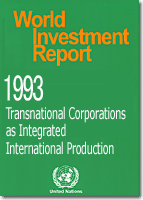|
Published by the United Nations Conference on Trade and Development - UNCTAD
WORLD INVESTMENT REPORT 1993
Transnational Corporations and Integrated International
Production

The World Investment Report 1993 analyses the evolving
strategies and changing organizational structures of TNCs, and
the implications of the increasing functional, cross-national
integration of their activities for the location of
international production. In spite of an overall decline in
world-wide flows of foreign direct investment in the early
1990s, there are many features of the world economic environment
pointing to a continuing and important role for transnational
corporations.
The report includes a statistical annex with FDI statistics
and other related indicators.
|
Table of contents
Preface
Overview
PART ONE: Recent Trends
Chapter I
Global Trends in Foreign Direct Investments
A. Trends
B. The universe of transnational corporations
C. The policy framework
Chapter II
Regional Trends
A. Developed countries
B. Developing countries
C. Central and Eastern Europe
Chapter III
Sectoral Trends
A. Overall trends
B. The primary sector
C. The secondary sector
D. The tertiary sector
E. Conclusions
Chapter IV
The growth of foreign direct investment in the 1980´s: The bulge in the trend
A. Short term factors
B. Policy changes
C. Structural factors
D. Future prospects
PART TWO: Integrated International Production
Chapter V
Strategies of transnational corporations
A. The functional scope of international production
B. The geographic scope of international production
C. Conclusions
Chapter VI
Organizational structures of transnational corporations
A. Structures of transnational corporations under complex strategies
B. Integrated international production at the firm level
C. Conclusions
Chapter VII
Integrated International Production and its implications
A. The characteristics of the system
B. The geographic structure of integrated international production
C. Implications for host countries
PART THREE: Public Policy Issues
Chapter VIII
Corporate Nationality
A. The grounds of corporate nationality
B. Corporate nationality: where and how it matters
C. Integrated international production and corporate nationality
D. Towards more order and clarity
E. Looking ahead
Chapter IX
Parent-Affiliate relations and responsibilities
A. The parent-affiliate dichotomy
B. National legislative and judicial approaches
C. Options for consideration
D. Public opinion and corporate good will
E. Conclusions
Chapter X
Tax Policy
A. Problems of allocating business income
B. Income allocation in an integrated international production system
C. Alternative methods for dealing with the allocation of income
D. Some implications for tax policy
Chapter XI
Investment Policies
A. Competition for investment and the convergence of investment policies
B. Investment policies in developing countries
C. International production, competitiveness and systemic convergence
References
Annex Tables:
Table 1: Foreign-direct-investment inward flows, by region and economy, 1981-1991
Table 2: Foreign-direct-investment inward and outward stock, 1980, 1985 and 1990
Table 3: The ratio of foreign-direct-investment inflows to gross domestic capital formation
and the ratio of gross domestic capital formation to gross domestic product,
1971-1975, 1976-1980, 1981-1985, 1986-1991
Table 4: Average annual inflows of foreign direct investment to the
Ten largest developing economies, 1970-1980, 1981-1991
Table 5: New bilateral treaties for the promotion and protection of foreign direct
investment signed or entered into force in 1991 and 1992
Table 6: Changes in main national legislation relating to foreign direct investment in 1992
Table I.10: The largest 100 non-financial transnational corporations, ranked by foreign assets, 1990
Select list of publications of the UNCTAD Programme on Transnational Corporations
Questionnaire
Book information:
UN Symbol: ST/CTC/156 -
Sales no.: E.93.II.A.14
Date of publication: 01/08/93 -
No. of pages: 290
To order: Order
form
|
|
|